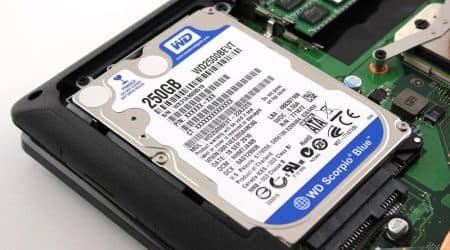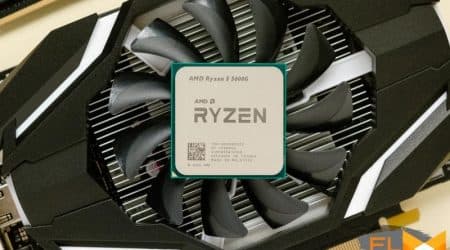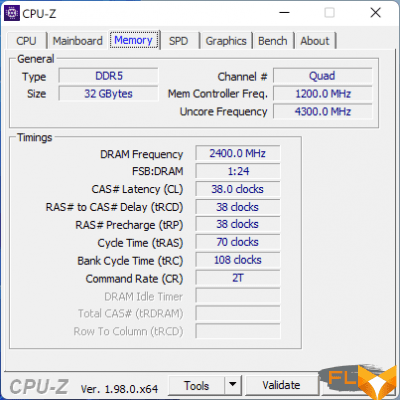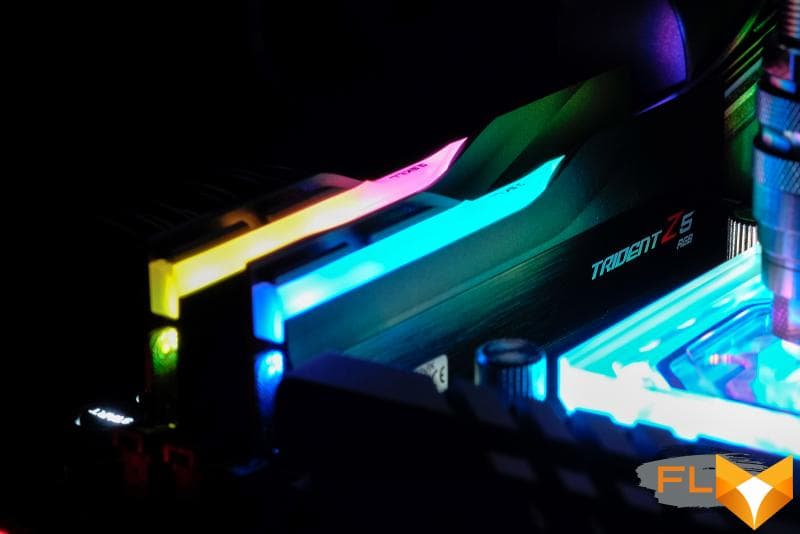


Alder Lake processors have brought with them a critical mass of new technologies that have made them the best CPUs not only for gaming workloads, but also for workloads. One of the important innovations that Intel pays special attention to is support for DDR5 SDRAM. Thanks to the increase in effective frequency, the new generation memory provided a noticeable increase in throughput when accessing data from the processor, which was probably one of the components of Alder Lake’s success. At least, that’s what one might think, since most of the reviews of recent Intel ® processors that can be found on the Web are conducted using DDR5 SDRAM, and all flagship motherboards on the market with an LGA1700 processor socket are focused on support for this type of memory.
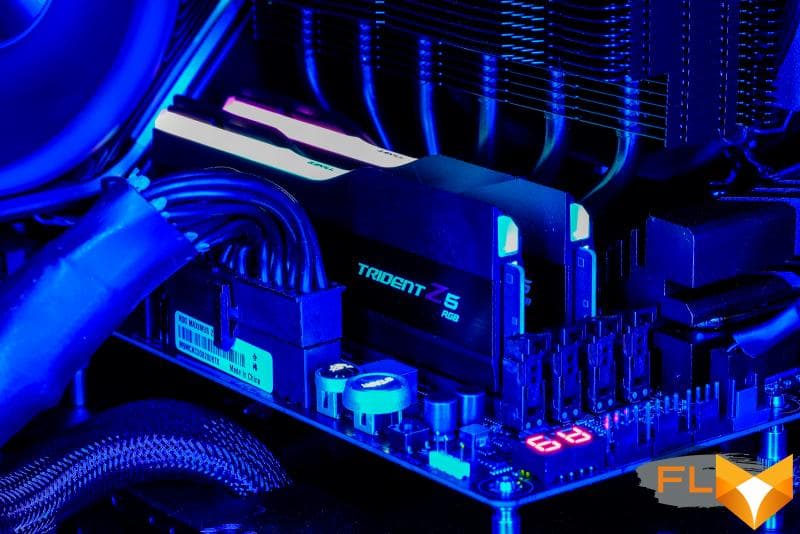
But fortunately, Alder Lake processors have a flexible memory controller, which, along with support for DDR5 SDRAM, has retained compatibility with the familiar DDR4 SDRAM. This support is implemented at the motherboard level – among the LGA1700 motherboards available on store shelves, there are motherboards with DIMM slots for both DDR5 and DDR4 (but not both at the same time). Therefore, users who do not consider it expedient to spend money on DDR5 have the opportunity to complete systems with new processors with common memory of the past standard.
A natural question arises: is some important advantage of Alder Lake lost when choosing DDR4 SDRAM? This article will be devoted to the answer to it, in which we will compare in practice the behavior of new processors when working with DDR4 and DDR5. A detailed study is necessary, since DDR4 does have a lower operating frequency, and therefore less bandwidth, but it can provide about a 1.5-fold advantage in latency. In other words, the confrontation between DDR4 and DDR5 comes down to identifying the factor that affects the performance of Alder Lake and other modern processors more – latency or bandwidth.
The dual-channel memory subsystem with common DDR4-3600 CL16 modules provides a peak bandwidth of about 57 GB / s and a CAS latency of 8.9 ns. At the same time, the memory subsystem on very fast (by modern standards) DDR5-6000 CL36 modules can deliver 96 GB / s with a latency of 12 ns. From this simple example, it is clear that there will most likely not be an unambiguous conclusion about the advantages of one or another type of memory. For some applications, it is more important to receive more data per unit of time, but for some, it is more critical that the data arrive faster. At the same time, the difference in the parameters of the memory subsystems can partly be smoothed out by the capacious Alder Lake L3 cache, which reaches 30 MB. All this can be taken as an argument in favor of the optional DDR5 when building systems based on Alder Lake, and if they are confirmed in practice, this will mean a significant reduction in the entry threshold into the LGA1700 ecosystem for many enthusiasts. It remains only to check everything properly, and we will do this as part of a partner project with Intel, which did not object to testing Alder Lake with DDR4, but, on the contrary, provided a complete set of necessary equipment for this testing.
⇡#What really makes DDR5 SDRAM so good
At the time of the announcement of the Alder Lake family of processors, Intel listed support for DDR5 SDRAM as one of their important advantages. There were arguments about the abstract “innovation” of a new type of memory, the company’s superiority in its implementation in the desktop platform, as well as a significant increase in frequency and bandwidth. But users looked at these claims with skepticism. They obviously didn’t like the inherent DDR5 latencies, and also the fact that the supported frequency of the new type of modules declared in the Alder Lake specifications was not too far from the frequency that modern DDR4 SDRAM can handle.
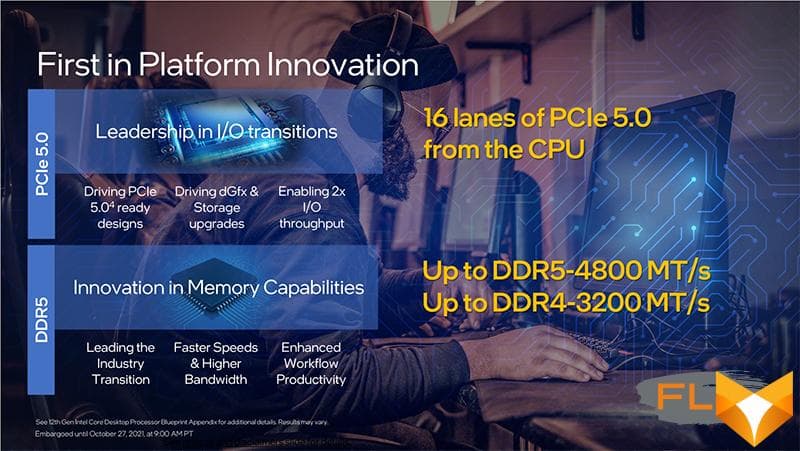
If you look at the specifications of the 12th generation Core™ processors, they are only promised compatibility with DDR5-4800. Modules of this type presented in stores can at best offer a timing scheme of 36-36-36-72, but more likely it will be 38-38-38-76 or even 40-40-40-76. Against the background of quite ordinary memory, for example, DDR4-3600 with delays of 16-18-18-36 or overclocker DDR4-4400 with timings of 19-19-19-43, DDR5 with such parameters really looks pale.
But not everything is so sad. Firstly, memory manufacturers are already ready to offer DDR5 with frequencies up to 6000 MHz, and such memory is compatible with Alder Lake desktop processors without any problems, although this is not reflected in the specification. And secondly, and more importantly, DDR5 implies not only a straightforward increase in the data transfer frequency. In fact, the new standard brings with it quite significant changes in the architecture and logic of the memory subsystem, due to which its efficiency increases. For example, according to Micron, operating at the same frequency as DDR4 SDRAM, DDR5 is actually capable of transferring 36% more data, and the transition from DDR4-3200 to DDR5-4800 gives an 87% increase in practically observed throughput.
But where do such growth values come from, seemingly from scratch? To understand this, it is necessary to remember that those frequencies that are put in the name of memory types are not actually the frequencies of the memory itself. RAM cores, which are an array of miniature capacitors, have been operating at approximately the same low frequency for many years – about 200 MHz. Only the effective frequency of the memory module interface grows, which is provided not by the acceleration of DRAM devices, but by an increase in their number – that is, by increasing parallelism.
This is exactly what happened in the transition from DDR4 to DDR5. The new memory modules offer twice as many bank groups (8 vs. 4), while the number of banks per group remains the same as before (4). And this not only allows data to be filled with data twice as fast as the memory bus, but at the same time increases the efficiency of transactions, since the increase in the number of bank groups allows you to leave more pages open at the same time and thereby increase the likelihood of accessing data in a simple scheme – with low latency.
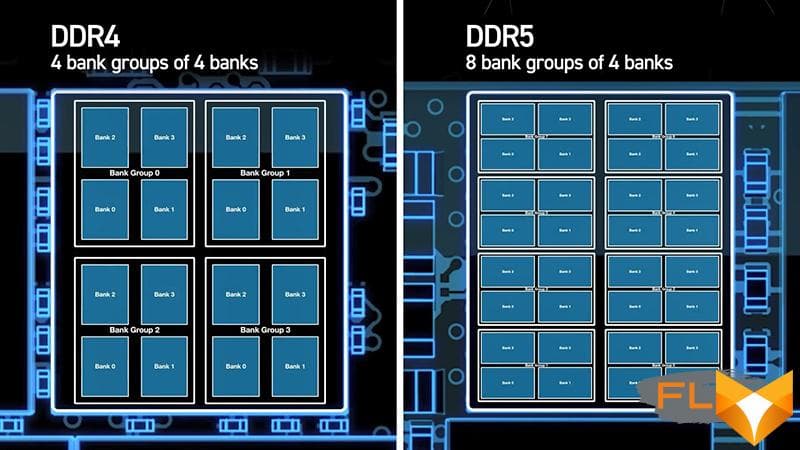
An increase in the frequency of the memory interface, that is, the density of information transmitted over the memory bus, is provided by another simple trick – doubling the length of the packets that are used to transfer. If in DDR4 SDRAM one package included 8 sequential transfers over the data bus, then in DDR5 there were 16 of them, which, accordingly, led to an increase in effective speeds, which are just indicated in the name of the modules as a four-digit number.
However, at this stage there was a problem associated with an excessive increase in the size of the package. The data bus width of a conventional memory module is 64 bits, and combining 16 transfers in one packet means that 128 bytes of data would come from the module in one receive. From the point of view of modern processors, this is a very inconvenient amount, since the length of the cache memory line is half that – 64 bytes. To eliminate this inconsistency, another fundamental change was made to the DDR5 architecture – the 64-bit bus of each module was divided into two independent 32-bit parts.
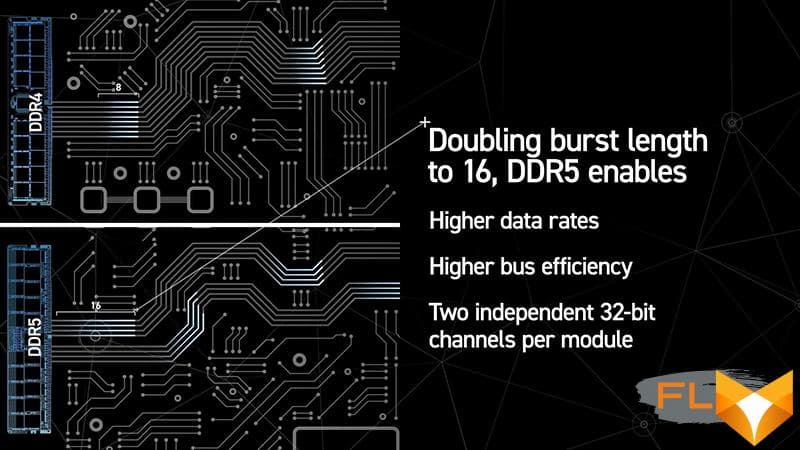
In other words, a single physical DDR5 module is logically organized as two independent modules with a 32-bit bus, assembled on a single piece of PCB. Thus, in DDR5, the dual-channel access mode is implemented within one module. And it is this innovation, in addition to increasing the effective frequency, that people pay attention to first of all when talking about the advantages of DDR5 over DDR4. However, you need to understand that this actually does not bring an increase in data transfer rate, since one 64-bit channel is replaced by two channels with a width of 32 bits. However, such an organization can still give a certain gain due to the fact that it allows you to perform two different operations with the halves of the module at the same time – before this possibility did not exist.
An additional increase in the efficiency of DDR5 is also achieved due to the fact that such a memory has learned to “refresh” information in cells according to banking, while previously this operation was carried out for all banks at once. Regeneration of the charge in the memory cells is the key to data safety and requires repetition at set intervals. This process in DDR4 required the termination of any other operations, which in fact periodically blocked any useful operations. In DDR5 memory, it became possible to perform regeneration in turn for different banks in groups, while the rest of the banks remain available for access. And it increases DDR5 performance by an additional 6-9%.
But in the end, all architectural changes in DDR5 increase its speed in terms of an increase in data transfer frequency and more efficient bus use. The issue of latency is bypassed. And why this is so is quite obvious. Nothing can be done about this characteristic: it is due to the delay of the basic DRAM cores and the time spent on the formation of longer data packets than before.
⇡#Alder Lake Memory Controller Features
In order for Alder Lake processors to realize the full potential inherent in DDR5 SDRAM, they are equipped with two dual-channel memory controllers – a controller for each “channel” in the usual sense (in the most common case, a controller per module). In the event that DDR4 SDRAM is used in an Alder Lake processor system, only the first channel is used in each of the two controllers. If DDR5 SDRAM is used in the system, then two channels of each of the controllers work with pairs of 32-bit subchannels implemented within the modules. This means that DDR5 SDRAM allows quad-channel memory mode to be enabled on Alder Lake processor-based systems, while only dual-channel mode is available when using DDR4 SDRAM. But do not forget: the total width of the memory bus in both cases remains the same – 128 bits. It’s just that in the case of DDR5, it is formed by four 32-bit channels, and in the case of DDR4, it is formed by two 64-bit channels.
| DDR4 SDRAM – two channels | DDR5 SDRAM – four channels |
Another key point is the use of multipliers that link the frequency of memory controllers with the frequency of the memory bus and were introduced back in Rocket Lake. In the past generation of processors, there were two such multipliers, and in the current one there are already three. They are conventionally called Gear 1, Gear 2 and Gear 4 and in fact ensure the operation of the memory bus at a frequency that either matches the frequency of the memory controller (Gear 1), or doubles it (Gear 2), or quadruples it (Gear 4) . The need for such dividers is due to the fact that the maximum frequency achievable for the memory controller that is part of the CPU is limited, and its upper limit is significantly lower than the speeds that memory modules are capable of, especially DDR5 SDRAM.
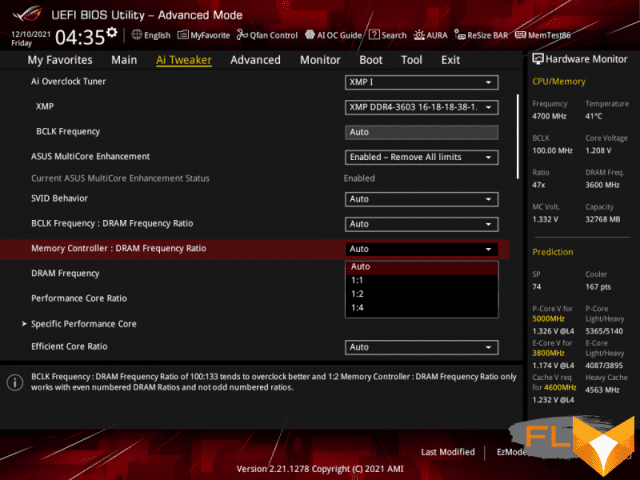
In Rocket Lake processors, the maximum frequency memory mode possible when choosing the most efficient Gear 1 multiplier in terms of performance (that is, in synchronous mode) was DDR4-3600 or, with luck, DDR4-3733. In Alder Lake, the memory controller has become a little more pliable and can be pushed closer to 4.0 GHz. Nevertheless, the border at which the controller automatically switches from Gear 1 to Gear 2 mode still formally remained at 3.6 GHz. In sum, this means that with default settings, synchronous memory mode is available in Alder Lake for modules with speeds up to DDR4-3600, but with manual configuration in Gear 1, DDR4-4000 can also be made to work. Fortunately, switching controller modes at the request of the user is available in the BIOS of almost any LGA1700 motherboard.
The transition to faster DDR4 memory will require, in any case, to abandon synchronism and switch to Gear 2 mode, the inclusion of which, as before, imposes a certain penalty on the performance of the memory subsystem. For this reason, using high-speed DDR4 with Alder Lake is not the best idea. It is much more rational not to go beyond the synchronous Gear 1 and limit yourself to using DDR4-3600 or DDR4-4000.
But with DDR5 the situation is completely different. The frequencies of the simplest modules start at DDR5-4800, which means that the Gear 1 synchronous mode cannot be available in principle for them. Therefore, for any DDR5, you need to use the Gear 2 memory bus doubling mode. It is applicable to all currently existing DDR5 modules, and it is what the Alder Lake memory controller will enable by default when installing the processor in any motherboard that supports DDR5 SDRAM.
The Gear 4’s quadruple memory multiplier is also workable, but it makes no sense to use it now. The penalty imposed on performance when it is activated is higher than with the Gear 2 multiplier. Therefore, it may only be required when the memory controller frequency reaches borderline values with the Gear 2 mode, that is, not earlier than the DDR5 frequencies step over the 7200 MHz mark .
There is one more detail to be noted. The frequency of the memory controller is formed similarly to the processor frequency – as the product of a multiplier by a certain base frequency. This base frequency in LGA1700 systems can be selected from two options – 100 or 133 MHz. There is no difference in performance between these values, but they affect the set of memory frequencies available for selection, determining the step between the nearest values. But here there is a nuance – the maximum working multiplier that is applicable for the frequency of the memory controller in Alder Lake is 30x, so in the case of high-speed DDR4 options in Gear 1 mode, the base frequency of the memory controller of 100 MHz is useless. On DDR5 systems using Gear 2 mode, however, both settings can be easily selected, although DDR5 motherboards tend to use 100MHz by default.
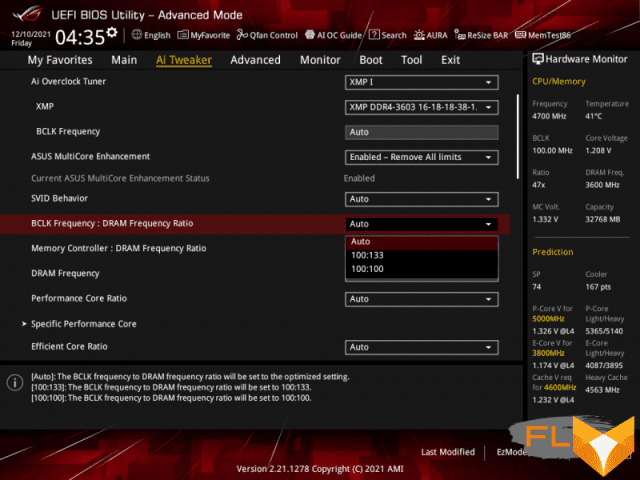
In principle, modern motherboards take all this into account automatically when choosing one or another memory option, however, the BIOS of motherboards has the ability to manually switch the base frequency for the memory controller.
⇡#How DDR5 SDRAM is powered
Another noticeable difference between DDR5 modules is that they use a different power supply scheme and lower voltages. The voltage converter in the new memory has moved from the motherboard to the modules themselves, and now they receive 5 V from the board and form the necessary voltages directly on the spot from it. This improves the stability of the power supply of the chips and reduces electromagnetic interference, however, the modules themselves, due to the need to place power elements on them, now turn out to be somewhat more expensive. But thanks to this, problems with unsuccessful power schemes for DIMM slots on motherboards should be a thing of the past.
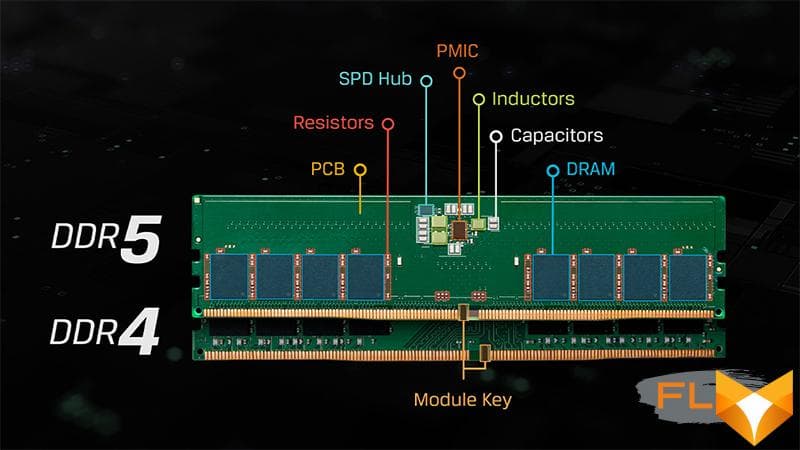
The integrated power management circuit installed on each module, according to the specification, must supply voltages to five lines, of which two main voltages are significant: VDD – the voltage supplied to the memory cores, and VDDQ – the voltage to the I / O circuits. The nominal value of these voltages is 1.1 V, however, overclocker memory manufacturers immediately began to overestimate these values, since this helps DDR5 memory chips to work stably at higher frequencies.
Despite the transfer of power circuits from the motherboard to modules, the ability to control memory voltages through the BIOS has not gone away. LGA1700 boards offer a full range of memory power management, and VDD and VDDQ voltages can be increased to at least 1.435V in 5-10mV steps. At the same time, there are modules with a higher upper voltage change limit – this is determined by the power controller that the manufacturer has chosen. Also, since each module has its own voltage regulator, their power can be controlled separately.
Contrary to expectations, a decrease in the main voltages from which DDR5 chips are powered by 0.1 V compared to DDR4 does not entail a decrease in module heating. On the contrary, it looks like DDR5 will experience relatively high temperatures.
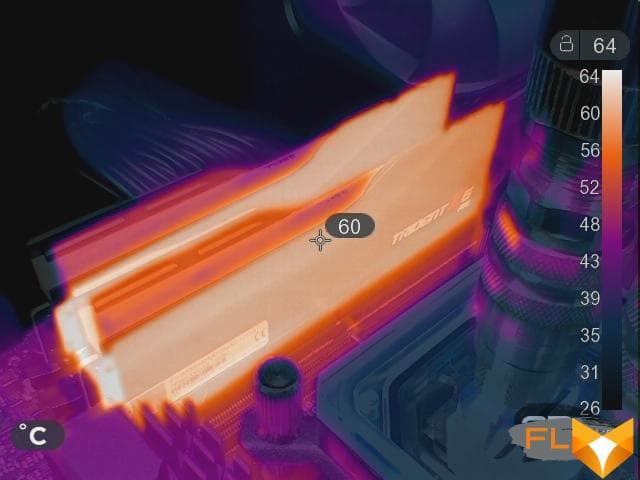
It’s all about the power circuit, which generates quite a lot of heat, especially in the case of increased voltages. Therefore, massive heatsinks on overclocker DDR5 SDRAM modules are by no means decorative, but a really necessary element.
⇡#Perfect DDR5 – G.Skill Trident Z5 RGB F5-6000U4040E16GX2-TZ5RK
For testing, we were able to get G-Skill’s Trident Z5 RGB DDR5-6000 memory. The F5-6000U4040E16GX2-TZ5RK kit that we received includes two 16 GB modules. Each of these modules, as befits an overclocker DDR5, is equipped with heat-dissipating plates and controlled RGB lighting passing along their upper edge.
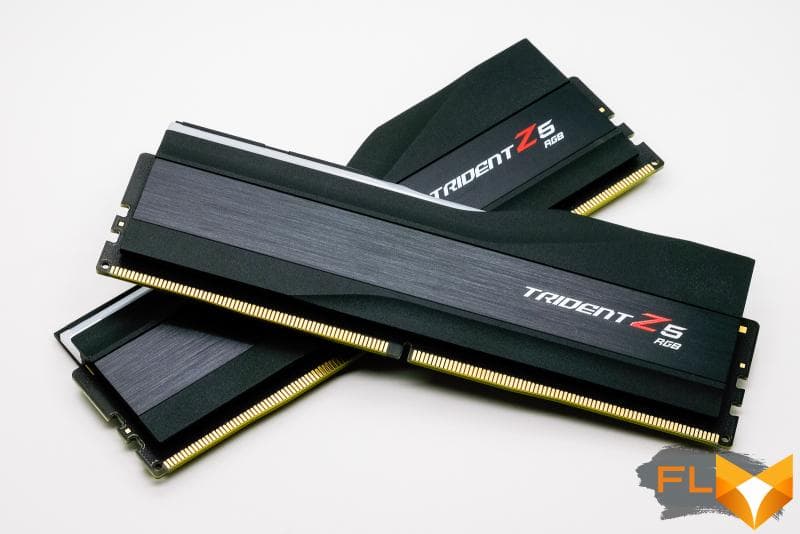
From the photos of G.Skill memory, it is easy to see that DDR5 modules are very similar to DDR4 modules. And indeed it is. They have the same dimensions, and even the number of contacts in the knife connector remains the same – 288 pieces. However, DDR5 and DDR4 are not interchangeable not only at the logical level, but also at the mechanical level. Installing a new type of module in a DDR4 DIMM will not work, at least due to a different location of the slot key in the slot. He moved closer to the middle of the module, even if it is not immediately evident.
Although the F5-6000U4040E16GX2-TZ5RK memory is designed for 40-40-40-76 timings, while the company has a similar option with more aggressive 36-36-36-76 timings, it still turned out to be an ideal testing ground for experiments. The reason is primarily that G.Skill’s high-speed DDR5 SDRAM variants use selected Samsung chips, which currently seem to be the best option in terms of frequency scalability with increasing voltage. In other words, this memory can be called a full-fledged successor to DDR4 modules with the legendary Samsung B-die chips.
In fairness, it should be mentioned that DDR5 chips produced by SK Hynix also have good overclocking potential, but memory based on them is still very rare. At the same time, the most common Micron chips, unfortunately, scale rather poorly. However, they can be found in the most common DDR5-4800 and DDR5-5200 modules, and it is almost impossible to make such memory kits work in DDR5-5600 modes or faster.
According to the specification, the G.Skill F5-6000U4040E16GX2-TZ5RK kit is designed to operate at a voltage of 1.3 V – this voltage is approximately 20% higher than the standard value, which is set by the standard for DDR5 SDRAM at 1.1 V. However, the situation with DDR5 memory is the same as with DDR4 – it is the increase in the supply voltage that becomes the foundation for the increase in frequency. And the level of 1.3 V does not seem too high – some DDR5 manufacturers are not shy about declaring even higher voltages for their memory – up to 1.4 V.
The modules included in the G.Skill F5-6000U4040E16GX2-TZ5RK kit are peer-to-peer, each module is based on eight 16-Gb chips. Unfortunately, there are no dual-rank DDR5 modules with a capacity of 16 GB, this is due to the fact that 16 GB is the minimum capacity of available chips.
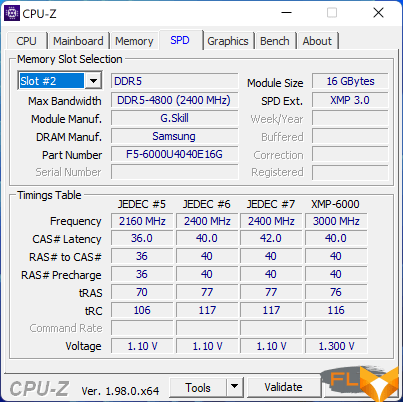
G.Skill pre-tests its high-speed DDR5 modules for compatibility with LGA1700 boards from ASUS and MSI, and these boards can be recommended to unlock all the capabilities of the new memory. To facilitate configuration, the F5-6000U4040E16GX2-TZ5RK has an XMP profile, but the XMP 3.0 features are not yet used in these modules. There is only one variant of the settings prepared by the manufacturer.
⇡#Description of the test system and testing methodology
Above, we described in detail how DDR5 is superior to DDR4 in terms of theory. However, calculations still do not answer the question whether the set of improvements proposed in the new memory is sufficient for consumers to have a real incentive to use DDR5 SDRAM with Alder Lake processors. Indeed, firstly, economic factors are clearly not in favor of DDR5, and secondly, this memory repels itself with too high latencies.
To resolve all doubts, we decided to study the performance of Alder Lake when the system is equipped with common variants of DDR4 and DDR5 modules operating at various frequencies.
The test systems included the following components:
- Processor: Intel Core i7-12700K (Alder Lake, 8P+4E-cores + HT, 3.6-5.0/2.7-3.8GHz, 25MB L3).
- CPU cooler: EKWB custom coolant
- Motherboards:
- ASUS ROG Strix Z690-F Gaming WiFi (LGA1700, Intel Z690);
- ASUS ROG Strix Z690-A Gaming WiFi D4 (LGA1700, Intel Z690).
- Memory:
- 2 × 16GB DDR4-3600 SDRAM, 14-15-15-35 (G.Skill Trident Z Neo F4-3600C14D-32GTZN);
- 2x16GB DDR4-4400 SDRAM, 19-19-19-43 (Crucial Ballistix MAX BLM2K16G44C19U4B);
- 2 x 16GB DDR5-4800 SDRAM, 38-38-38-70 (Kingston Fury Beast KF548C38BBK2-32);
- 2x16GB DDR5-6000 SDRAM, 40-40-40-76 (G.Skill Trident Z5 RGB F5-6000U4040E16GX2-TZ5RK).
- Video Card: NVIDIA GeForce RTX 3090 Founders Edition (GA102, 1395-1695/19500MHz, 24GB GDDR6X 384-bit).
- Disk subsystem: Intel SSD 760p 2TB (SSDPEKKW020T8X1).
- Power supply: Thermaltake Toughpower DPS G RGB 1000W Titanium (80 Plus Titanium, 1000W).
The Core i7-12700K processor, which served as the basis for the test systems, was used in an overclocked state. The P-core frequency has been increased to 5.0 GHz, the E-core frequency to 4.0 GHz, and the L3 cache frequency to 4.3 GHz. The work of the test CPU in this state was possible when the supply voltage was increased to 1.425 V when the fifth level of Load-Line Calibration was selected. To improve the stability of memory operation at high frequencies up to 1.25 V, the voltage on the system agent was increased.
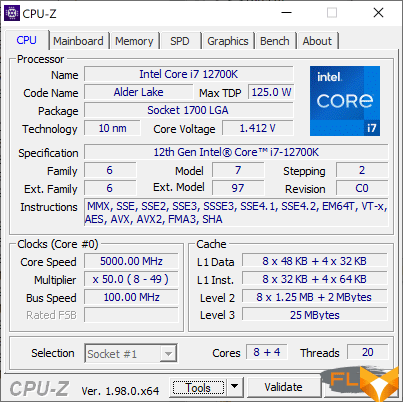
Testing was performed on the Microsoft Windows 11 Pro (21H2) Build 22000.282.0 operating system with updates KB5005635 and KB5006746 installed and using the following set of drivers:
- AMD Chipset Driver 3.10.08.506;
- Intel Chipset Driver 10.1.18838.8284;
- Intel SerialIO Driver 30.100.2105.7;
- Intel Management Engine Interface 2124.100.0.1096;
- NVIDIA GeForce 496.49 Driver
Description of the tools used to measure computing performance:
Applications:
- 7-zip 21.02 – archiving speed testing. The time taken by the archiver to compress a directory with various files with a total volume of 3.1 GB is measured. Uses LZMA2 algorithm and maximum compression ratio.
- Adobe Photoshop 2021 22.4.3 – Graphics performance testing. The average execution time of the Puget Systems Adobe Photoshop CC Benchmark 18.10 test script, which simulates the typical processing of an image taken by a digital camera, is measured.
- Adobe Photoshop Lightroom Classic 10.3 – Performance test for batch processing of a series of RAW images. The test scenario includes post-processing and export to JPEG at a resolution of 1920 × 1080 and a maximum quality of two hundred 16-megapixel RAW images taken with a Fujifilm X-T1 digital camera.
- Adobe Premiere Pro 2021 15.4.0 – performance testing for non-linear video editing. Measures rendering time to YouTube 4K for a project containing HDV 2160p30 footage with various effects applied.
- Blender 2.93.5 – testing the speed of the final rendering in one of the popular free packages for creating three-dimensional graphics. The duration of building the final model pavillon_barcelona_v1.2 from Blender Benchmark is measured.
- Corona 1.3 – testing the rendering speed using the renderer of the same name. The standard application Corona 1.3 Benchmark is used to measure performance.
- Microsoft Visual Studio 2017 (15.9.40) – Compile time measurement for a large MSVC project – Blender 2.79b professional 3D package.
- Topaz Video Enhance AI v2.3.0 – performance testing in an AI-based program to improve video detail. The test uses the original video at 640×360 resolution, which is doubled using the Artemis Anti Aliasing v9 model.
- x264 r3059 – testing the speed of transcoding video to H.264/AVC format. To evaluate performance, we use the original 2160p@24FPS AVC video file with a bitrate of about 42 Mbps.
- x265 3.5+8 10bpp – testing the speed of video transcoding to H.265/HEVC format. To evaluate performance, we use the original 2160p@24FPS AVC video file with a bitrate of about 42 Mbps.
Games:
- Chernobylite. Resolution 1920 × 1080: Graphics Quality = Ultra.
- Civilization VI: Gathering Storm. Resolution 1920×1080: DirectX 12, MSAA=4x, Performance Impact=Ultra, Memory Impact=Ultra.
- Cyberpunk 2077. 1920×1080 resolution: Quick Preset = Ray Tracing – Ultra.
- Far Cry 6. 1920 × 1080 resolution: Graphics Quality = Ultra, HD Textures = On, Anti-Aliasing = TAA.
- Hitman 3. 1920 × 1080 resolution: Super Sampling = 1.0, Level of Detail = Ultra, Texture Quality = High, Texture Filter = Anisotropic 16x, SSAO = Ultra, Shadow Quality = Ultra, Mirrors Reflection Quality = High, SSR Quality = High, Variable Rate Shading = Quality.
- Marvel’s Guardians of the Galaxy. Resolution 1920 × 1080: Graphics Preset = Ultra.
- Shadow of the Tomb Raider. Resolution 1920 × 1080: DirectX12, Preset = Highest, Anti-Aliasing = TAA.
- The Riftbreaker. Resolution 1920 × 1080: DirectX12, Texture Quality = High, Raytraced soft shadows = On, Ray traced shadow quality = Ultra, Raytraced ambient occlusion = On.
- A Total War Saga: Troy. Resolution 1920 × 1080: DirectX 12, Quality = Ultra, Unit Size = Extreme.
- Watch Dogs Legion. Resolution 1920 × 1080: DirectX 12, Quality = Ultra, RTX = Off, DLSS = Off.
In all gaming tests, the results are the average number of frames per second, as well as the 0.01-quantile (first percentile) for FPS values. The use of the 0.01-quantile instead of the minimum FPS is due to the desire to clean up the results from random bursts of performance that were provoked by reasons not directly related to the operation of the main components of the platform.
⇡#DDR5 vs DDR4 benchmarks
The first part of testing is devoted to comparing the performance of the Core i7-12700K when working with DDR4 and DDR5 memory when choosing modules of different frequencies. Here we will assume that the memory works with default settings, that is, all delays are configured automatically in the system using XMP profiles. This is the configuration approach used by most users, and the comparison in this section will show whether choosing a more modern and more expensive memory gives any preference in the most typical cases.
As typical DDR4 operating modes, settings were used that are characteristic of the popular Crucial Ballistix memory modules based on Micron Rev. chips. E: DDR4-3200 with 16-18-18-36 timings, DDR4-3600 with 16-18-18-38 timings, DDR4-4000 with 18-19-19-39 timings and DDR4-4400 with 19-19 timings -19-43. In all cases, the Command Rate parameter was set to 1T, and the Gear 1/Gear 2 modes were selected by default: DDR4-3200 and DDR4-3600 worked in synchronous mode with the memory controller, and for faster memory options, a controller-to-memory frequency ratio of 1 was used: 2.
DDR5 memory was also tested in four modes: DDR5-4800, DDR5-5200, DDR5-5600 and DDR5-6000. In all four cases, the 36-36-36-76 timing scheme and Gear 2 mode were used, however, the Command Rate 1T setting was used only for DDR5-4800 and DDR5-5200, while memory operation at a higher frequency required Command Rate to be enabled 2t.
Also in the context of this comparison, it is important to note that the DDR4 modules used in it, like most of the 16 GB modules of this type on the market, are dual-rank. At the same time, DDR5 modules of the same size always have a peer-to-peer organization.
So, after the necessary preliminary remarks, let’s finally look at the results of the Cache & Memory Benchmark from the AIDA64 utility. The results are quite expected: DDR5 noticeably wins in terms of throughput, while DDR4’s strong point is low latency.
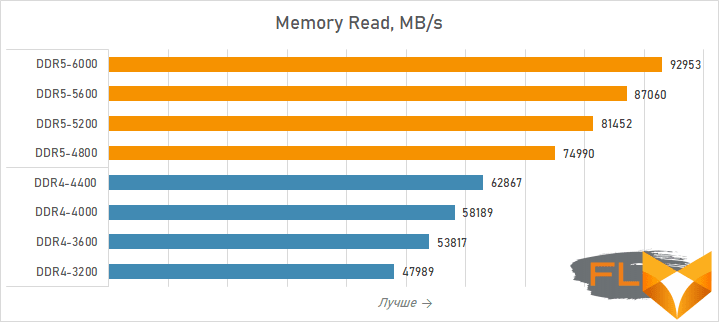
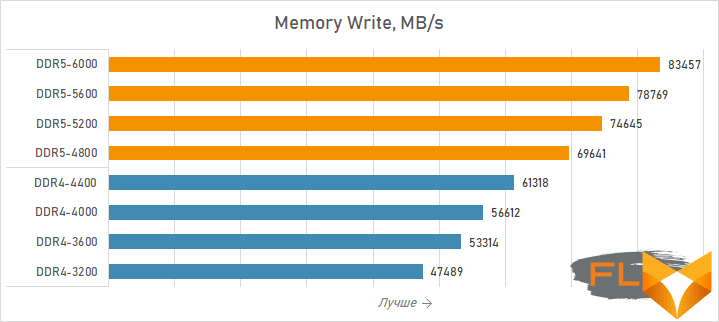
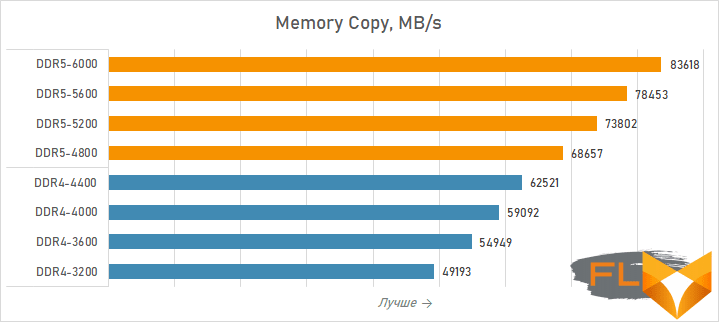
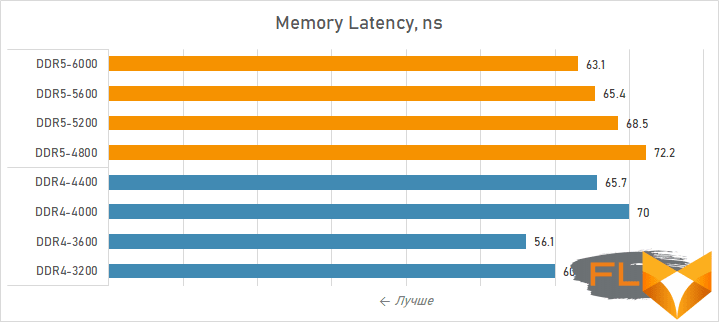
However, looking at the graphs, one can notice interesting nuances. So, we can state that DDR5 really shows itself to be a more efficient technology. While the practical bandwidth of DDR4 is 89-93% of the theoretical, in the case of DDR5 this figure rises to 97-98%. Thus, doubling the number of channels does have some positive effect, and scaling the performance of the memory subsystem when moving from DDR4 to DDR5 is faster than increasing the frequency.
At the same time, the increase in practical latency during the transition to DDR5 does not look catastrophic at all. Moreover, if DDR4 is running at high frequency in Gear 2 controller mode, there is no noticeable difference in latency at all. Only DDR4 synchronous modes with low latency, that is, DDR4-3200 and DDR4-3600, win over DDR5.
According to the results of the synthetic test, it seems that the choice of old DDR4 memory for Alder Lake should significantly limit its performance. However, testing in resource-intensive applications shows that this is far from the case. Tasks in which DDR5 provides unambiguously higher performance do exist. This pattern is observed, for example, when archiving files in 7-zip, batch processing photos in Lightroom, rendering video in Premiere Pro, transcoding video with the x265 codec, or when compiling code in Visual Studio. In them, even the slowest DDR5-4800 is faster than any of the DDR4 variants. Moreover, the performance advantage of even a primitive DDR5-4800 can in some cases reach a significant 8-10%, although basically we are still talking about superiority at the level of a few percent.
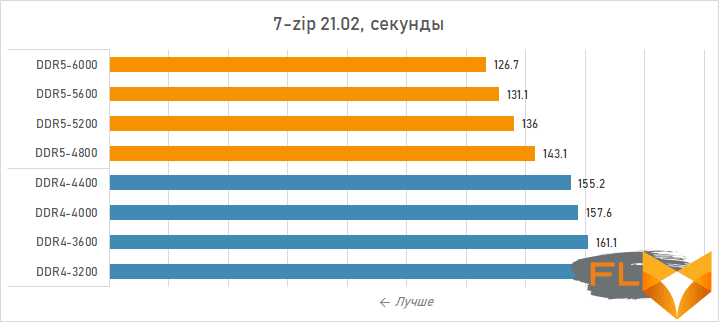

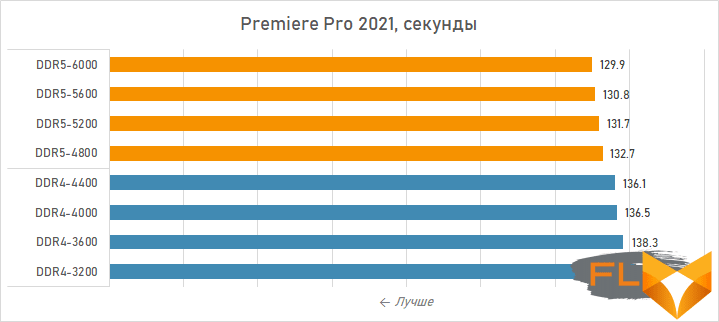

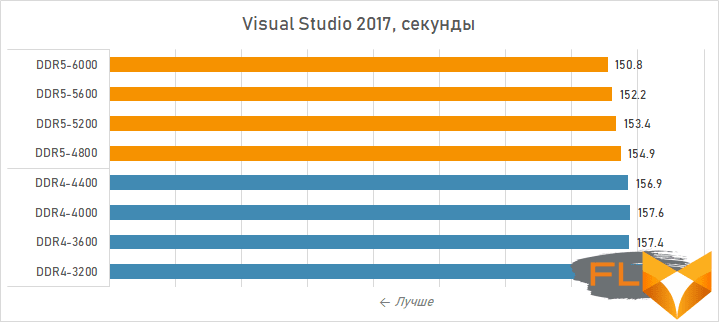
But at the same time, there are a lot of resource-intensive load options, the performance of which practically does not depend on the type of memory selected. Photo editing in Photoshop, video upscaling in Topaz AI, or final rendering are among the tasks where Alder Lake can perform just as well with DDR4 memory as it does with the latest DDR5.
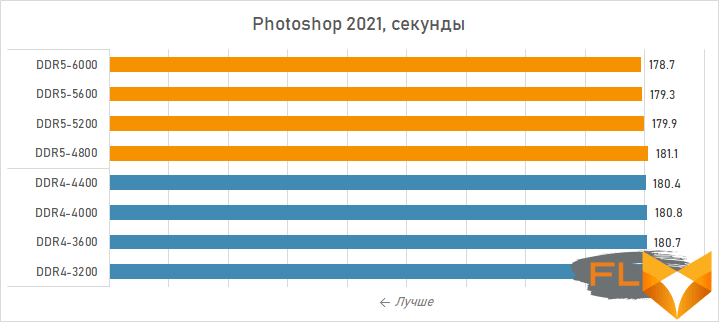
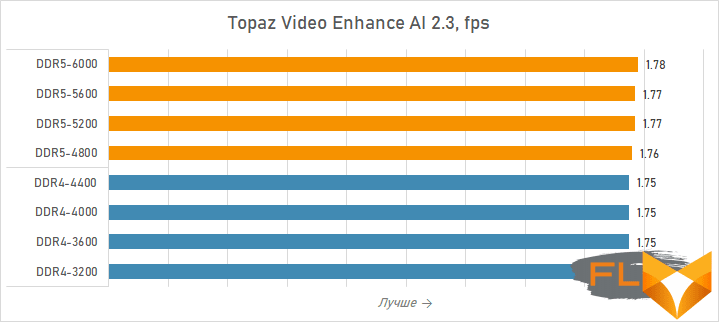
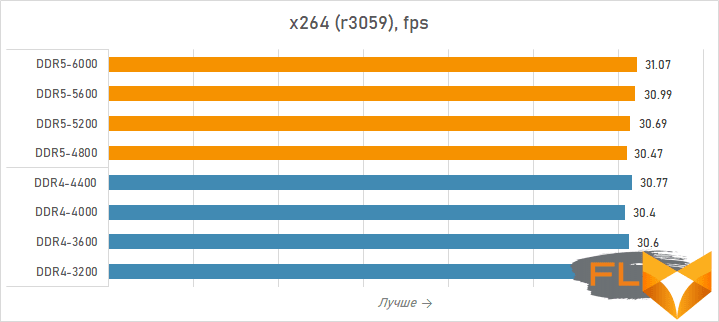
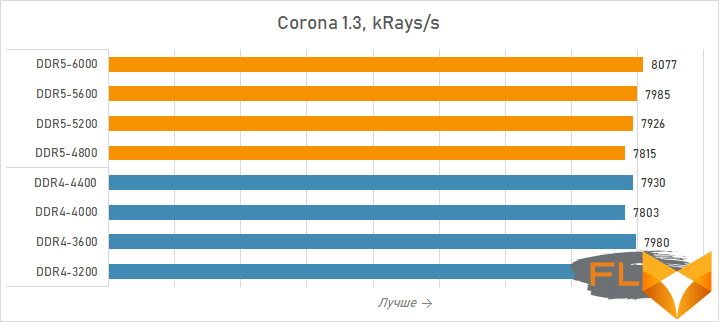
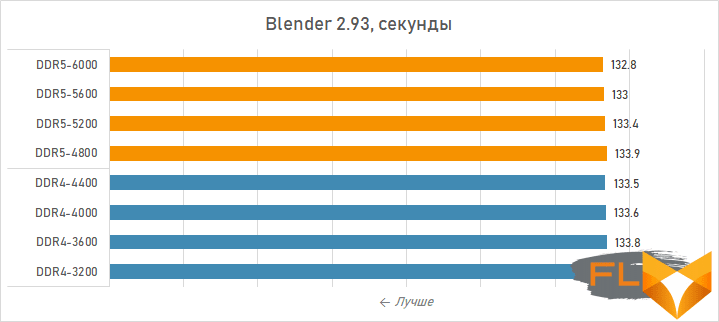
However, if you look at games, then DDR5 as a whole still looks more attractive. Below is a chart with average frame rates based on the results of tests in ten games. And it follows that DDR5-4800 delivers better performance than any of the DDR4 variants in terms of both average and minimum FPS. And if we talk about the currently fastest DDR5-6000 memory, then it achieves at least a 6% advantage in games over any of the available DDR4 options.
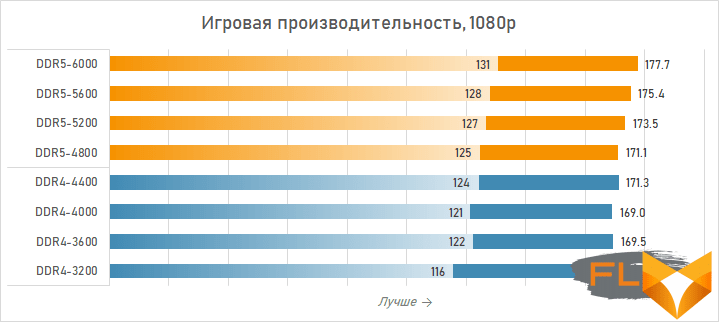
However, in some games, the performance ratio may not be the same at all. Of the ten games selected for testing, a clear advantage of DDR5 memory is manifested only in six. And in some cases, DDR4 memory with lower latency may even be a better option. For example, a similar situation develops in Chernobylite or in Far Cry 6.
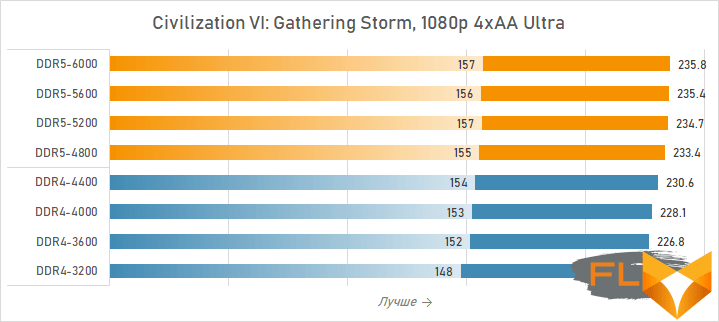
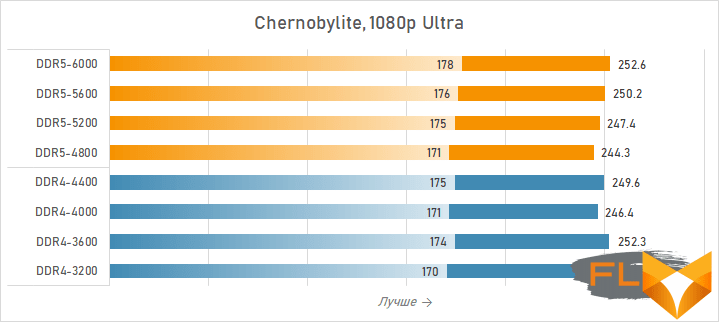
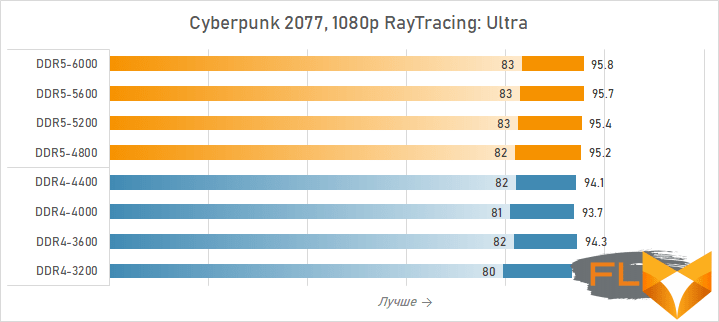

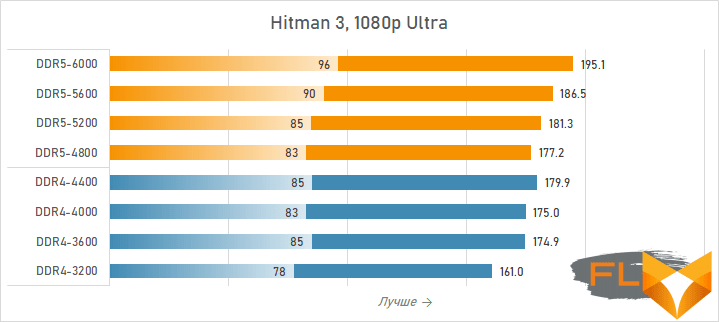
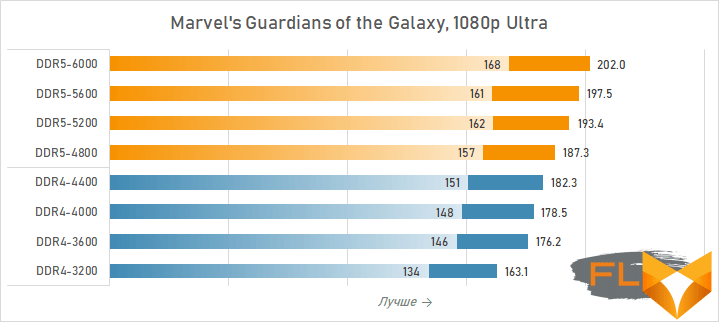
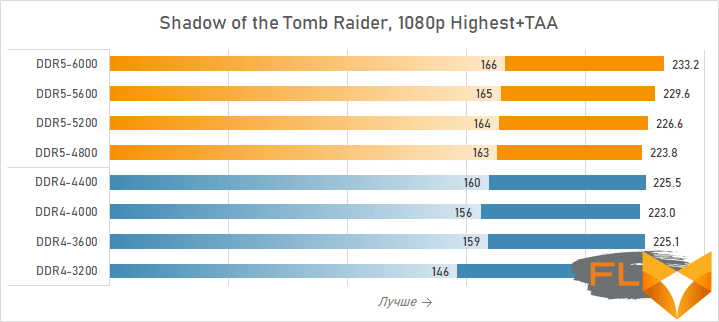
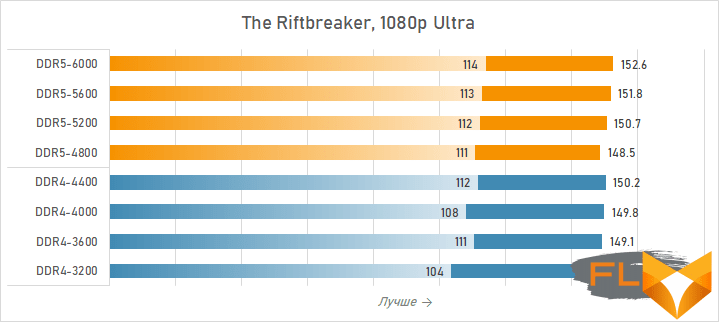
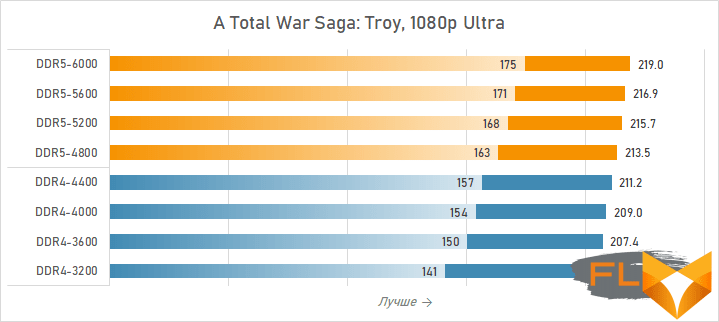
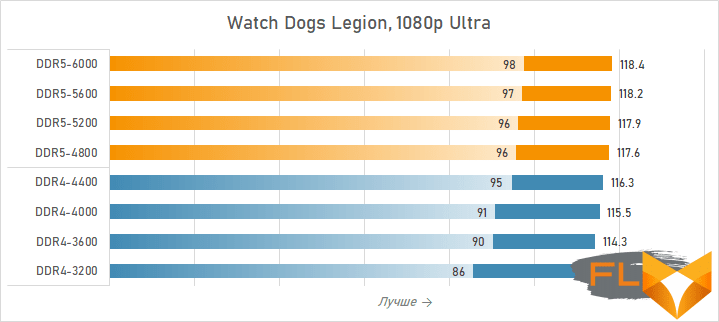
The conclusion from the presented results can be drawn as follows: yes, DDR5 really suits Alder Lake better, but so far we are not talking about any radical advantage. The new memory gives a few percent of the gain and can be really useful only in some piece of content processing tasks. As for gamers, it seems that there is no point in chasing DDR5 at all. Especially now, when this memory is not very affordable, both in terms of price and availability on the shelves.
However, for now, we were talking about how Alder Lake performs with different memory if the default settings are selected for it. At the same time, the memory subsystem in modern systems can be subjected to deep optimization through careful manual tuning of timings. And enthusiasts who are used to going this way may not agree with the results. Therefore, this testing has a second part, and we move on to it.
⇡#DDR5 vs. DDR4 with customized timings
In this section, we will talk about what happens if you try to squeeze more out of the memory modules available on the market by fine tuning. As we have repeatedly shown, the selection of timings that are more aggressive than those laid down in the specifications and XMP often leads to a significant performance improvement, at least in the case of DDR4. So maybe if such a memory is subjected to thoughtful optimization, it will turn out to be even better than DDR5? Let’s check.
In order to get the highest possible performance in a system with DDR4, in this part of the test we used a DDR4 SDRAM kit based on Samsung B-die chips. Such memory makes it possible to minimize delays more than any other kits. At the same time, we did not try to increase the memory frequency as much as possible, but aimed at working in the DDR4-4000 mode – the maximum in which Alder Lake makes it possible to use the same controller and memory frequencies, Gear 1. Synchronization quite noticeably reduces practical latencies, namely for this is what we are fighting, trying to extract additional performance percentages from DDR4.
In the end, the selected kit was able to work stably in the DDR4-4000 state with timings of 16-16-16-34, and you can see all the parameters in full on the screenshot.
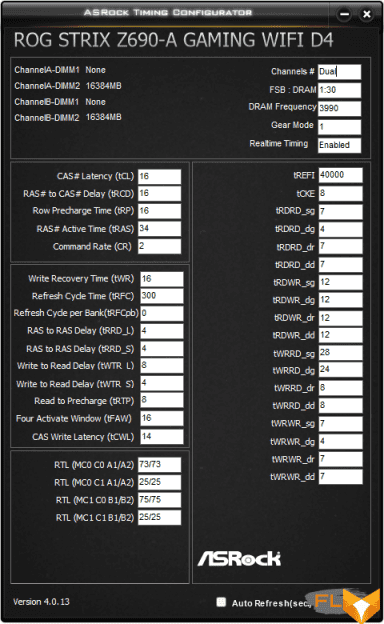
DDR4 memory with manually optimized timings is logical to compare with the same carefully tuned DDR5. Therefore, we tried to tweak the settings for the DDR5-6000 kit we have at our disposal. In addition, it could not accelerate in frequency, but it turned out to be pliable with a decrease in timings. Stability was not broken when choosing the scheme 34-34-34-68, and the full set of settings looked like this.
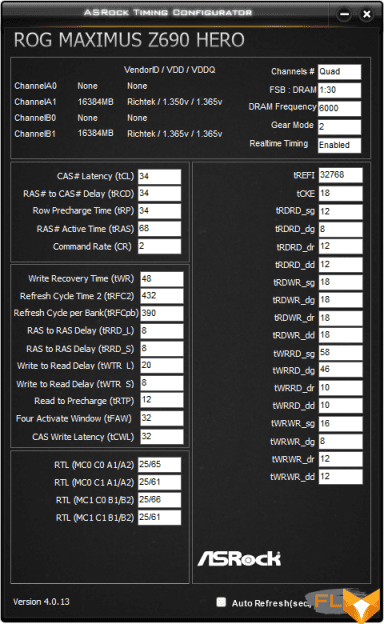
To make the comparison of the tuned DDR4-4000 and DDR5-6000 more visual, we also placed the performance indicators of the Alder Lake-based platform when using DDR4-3200 and DDR5-4800, the types of memory that are required for it according to the Intel specification, on the diagrams with the results. The timings in this case were selected by default, and this allows you to see how the parameters of the memory subsystem can affect the potential of a modern processor.
Let’s start again with the results of a synthetic memory test from AIDA64. It shows that the tuned DDR5-6000 is one and a half times better than the tuned DDR4-4000 in terms of practical throughput, but at the same time noticeably loses to it in terms of latency. In terms of latency, DDR4-4000 is 20% better.




The results obtained from synthetic testing make it clear that the relative performance of Alder Lake with DDR4 and DDR5 will not be the same as when tested with default settings. And the performance indicators obtained in applications are proof of this. DDR5 memory remains the preferred choice for data archiving, video transcoding, Lightroom and Premiere Pro. But at the same time, there are tasks where a tuned DDR4-4000 allows the Alder Lake processor to develop higher performance. This situation is observed in Photoshop, when compiling source code, or in Corona rendering.










The situation in games looks even more interesting. Judging by the graph of average gaming performance, DDR4-4000 almost does not lag behind DDR5-6000: the difference between these memory options does not exceed 1%. In other words, adjusting the DDR4 timings allows you to get a larger boost than the DDR5 setting, and as a result, the difference in performance of Alder Lake with different types of memory becomes very small, especially when using the system for gaming.

If you go through individual games, it turns out that DDR5 has an advantage over DDR4 in seven cases out of ten. But at the same time, a noticeable superiority of DDR5-6000, reaching several percent, is noted only in one game – Marvel’s Guardians of the Galaxy. In other cases, we are talking about an advantage at the level of 1-2%. And this means that in the current realities, DDR4 may well replace DDR5 in gaming systems. The only thing is that the memory must be of high quality, fast and carefully tuned.










⇡#Conclusions
Intel cites support for the new DDR5 SDRAM memory as one of the key benefits of Alder Lake. And this is partly true: DDR5 really helps these processors show record performance. However, the positive effect that such a memory gives should not be overestimated. The main reason why Alder Lake has been so successful is not the memory, but their microarchitecture. Therefore, LGA1700 systems equipped with DDR4 SDRAM have every right to exist: at least the memory of the previous generation does not damage Alder Lake processors.
Nevertheless, there is a certain range of applications for which DDR5 SDRAM has a truly magical effect. These applications combine streaming processing of large amounts of data, and in them, the use of DDR5 with high bandwidth can give a very noticeable performance boost – up to double-digit percentages. However, firstly, there are very few such applications, and secondly, games definitely do not belong to them. Therefore, we can talk about the importance of DDR5 only in relation to the configurations involved in specific professional activities that are associated with the processing of high-definition media content.
The majority of average users can easily switch to the new generation Intel platform in the DDR4 variant. But in order to maximize Alder Lake’s performance, when choosing DDR4 memory, the emphasis should be on a combination of sufficiently high frequencies and low latencies. The ideal option is memory that can operate at low latency in modes from DDR4-3600 to DDR4-4000. Also, manually minimizing the timings helps a lot to improve the performance of Alder Lake, although this process is rather laborious. But, as tests have shown, a tuned DDR4-4000 makes an Alder Lake-based gaming system almost as fast as if it had the latest DDR5-6000 installed.
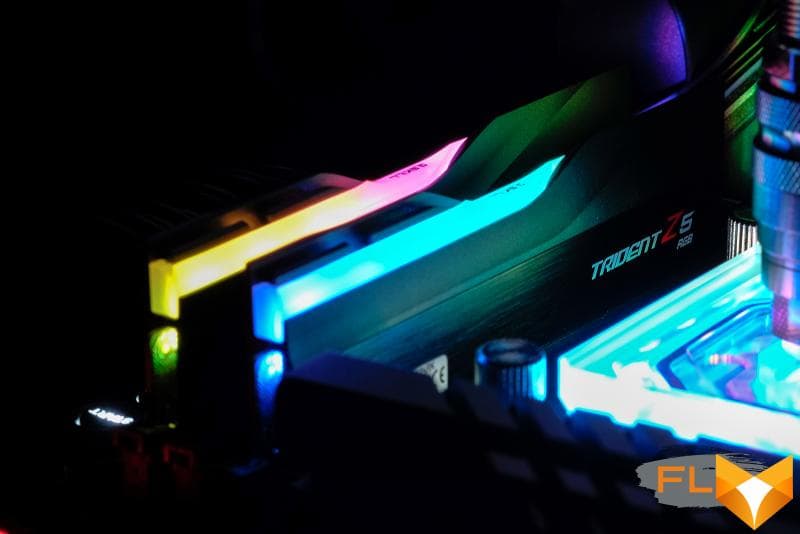
However, among the readers of this article, there will certainly be maximalists who will consider that combining the latest Core processors with memory of the past generation is not feng shui. And we recommend such enthusiasts to pay attention to DDR5 SDRAM kits, which scale well in frequency and allow lower timings. First of all, this is a memory based on Samsung chips, and secondly, on SK Hynix chips. Typically, such microcircuits end up in modules designed for DDR5-6000 and higher speeds.
But still, for the average user at the moment, the advantages of DDR5 are not so obvious as to justify its significantly higher price. Until DDR5 becomes widely available on the market, until its typical clock speeds rise by a couple of notches, until the cost of such modules no longer includes a premium for novelty and exclusivity, the familiar DDR4 SDRAM will remain the preferred option for Alder Lake. We failed to find any special synergy between the new processors and the new memory in its current form. In theory, DDR5 SDRAM has a higher efficiency, but as of today, DDR4 SDRAM confidently responds to the architectural improvements of the new memory with overclocking and low timings.
